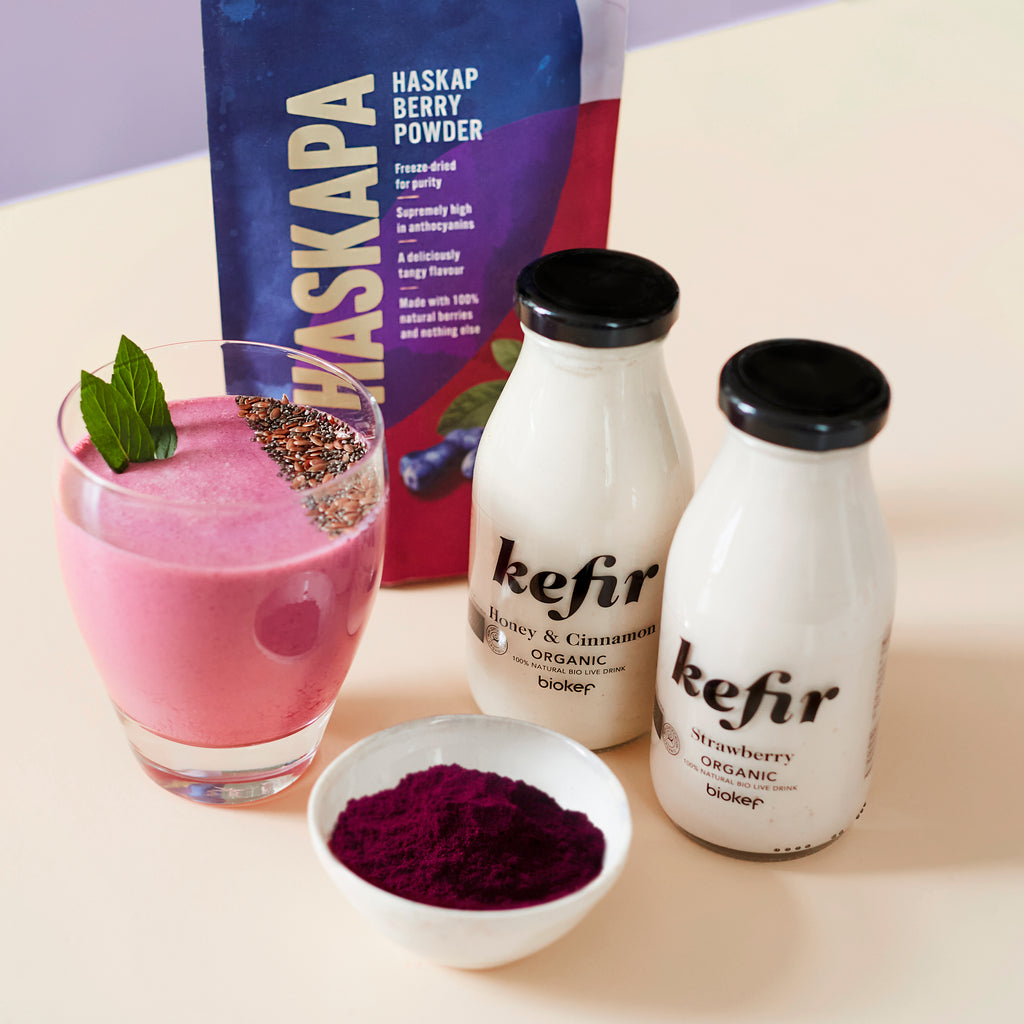Over the last few years many studies have been published which suggest that our gut bacteria (also known as our gut microbiome) can affect almost every aspect of our health including digestion, mood and obesity. There is plenty of advice to be found on how best to keep our microbiome healthy including eating prebiotic and probiotic foods.
Prebiotics and Probiotics
Prebiotics are foods containing certain types of fibre e.g. inulin which can pass through the gut undigested and stimulate the growth and activity of bacteria in the large intestine. Probiotic foods contain the actual ‘friendly’ bacteria that are considered beneficial for health.
Kefir
Kefir is a fermented milk drink and has become one of the most popular probiotics consumed today. It originated in the Black Caucasus mountains which run from southeast Europe into Asia. It is made by adding kefir starter ‘grains’ – a combination of yeast and bacteria, to cow, goat or sheep milk. Kefir grains will also ferment milk substitutes such as soya and coconut milk. Because it is fermented, most people who are lactose intolerant can actually drink kefir or eat kefir yogurt.
Haskapa powder and Kefir
Several of our Haskapa customers have told us that they love adding Haskapa berry powder to all types of Kefir drinks and yogurts, both for taste and health benefits. Adding just a teaspoon or two of Haskapa powder adds a purple anthocyanin berry boost to your daily Kefir drink.
Many people take Kefir to support their gut health. But would the addition of haskap’s anthocyanins add extra benefits for the GI tract and abdomen?
An important new study1 published in the American Journal of Clinical Nutrition in February 2020 certainly thinks so. The study looked at the contribution of the gut microbiome to some of the health benefits associated with anthocyanin/flavonoid intake.

Flavonoids and your gut
Flavonoids are a broad group of bioactive plant nutrients found in fruits and vegetables, and anthocyanins are one of the 6 flavonoid subclasses. Previously published epidemiological studies have shown that eating a high anthocyanin diet is associated with less weight gain in adulthood and reduced body fat accumulation. 2-3
Flavonoids have an important two-way relationship with the gut microbiome; flavonoid intake alters the composition of the gut microbiome and the gut microbiome metabolises flavonoids into compounds with increased biological activity.

Reducing visceral tummy fat
This new study looked at the effect of dietary flavonoids on two specific types of body fat; visceral fat, which lies out of reach deep within the abdominal cavity and surrounds the stomach, liver and intestines, and subcutaneous fat which is stored just under the skin. Visceral fat is of particular concern as it has been linked to an increased risk of developing heart disease and type 2 diabetes.
The researchers asked 618 men and women about their flavonoid consumption over the course of a year and assessed their body fat using MRI scans. In addition, they looked at the effect of flavonoid intake on the microbiome of the participants by examining stool samples.
The results showed that a higher regular intake of anthocyanins rich foods (such as berries) was associated with lower amounts of visceral fat, and improved microbial diversity. These associations were not seen in the other 5 flavonoid subclasses.
They also showed that people with the highest microbial diversity in their GI tract had an association with lower amounts of visceral fat in their abdomens. Using complex calculations, they estimated that around 18.5% of the association between the intake of anthocyanin-rich foods and visceral fat could be explained by the gut microbiome.
- Amy Jennings, Manja Koch, Majken K Jensen, Corinna Bang, Jan Kassubek, Hans-Peter Müller, Ute Nöthlings, Andre Franke, Wolfgang Lieb, Aedín Cassidy, The role of the gut microbiome in the association between habitual anthocyanin intake and visceral abdominal fat in population-level analysis,The American Journal of Clinical Nutrition, Volume 111, Issue 2, February 2020, Pages 340–350, https://doi.org/10.1093/ajcn/nqz299
- Bertoia ML, Rimm EB, Mukamal KJ, Hu FB, Willett WC, Cassidy A. Dietary flavonoid intake and weight maintenance: three prospective cohorts of 124 086 US men and women followed for up to 24 years. BMJ. 2016;352:i17.
- Jennings A, MacGregor A, Spector T, Cassidy A. Higher dietary flavonoid intakes are associated with lower objectively measured body composition in women: evidence from discordant monozygotic twins. Am J Clin Nutr. 2017;105:626–34.

